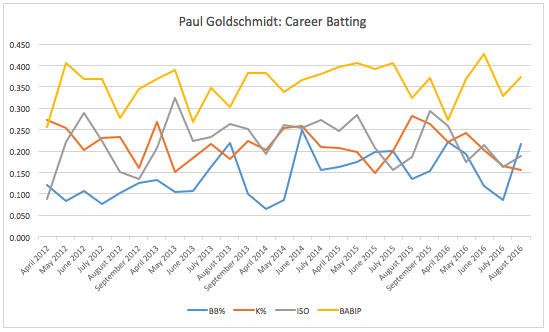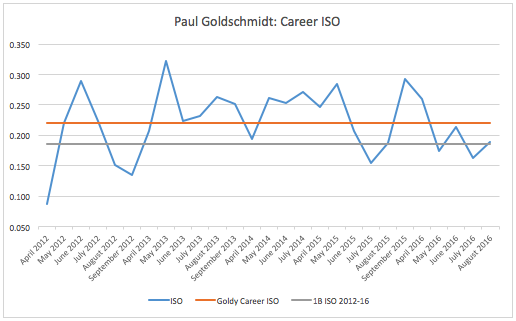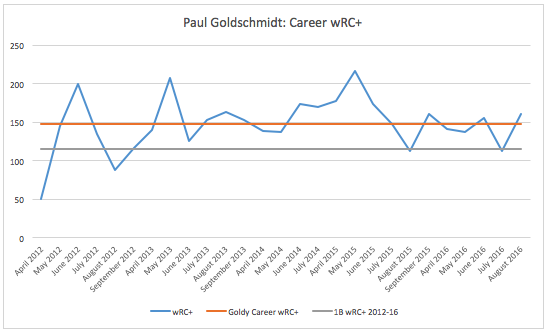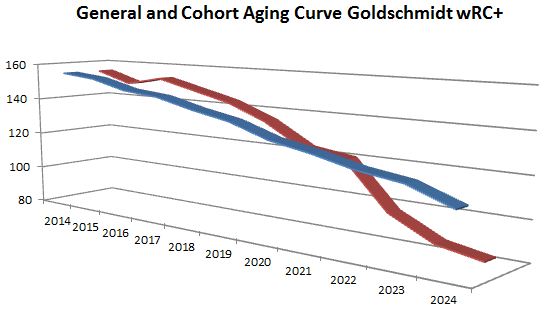A Little Less Golden: the Slow Decline of Goldschmidt May Be Here
It’s funny how easy it is to lose sight of a great player when that player is routinely great. As good as Paul Goldschmidt is, one can lose sight of his production when looking for storylines. It’s only when he gets off to a slow start or hits a walk off home run that we stop and take notice. One for three with a double and a walk? That’s a pretty routine night for America’s First Baseman. We hardly take notice.
And it wasn’t all that long ago that we legitimately worried about Goldy. After all, his start to the 2016 campaign was noteworthy for the wrong reasons. He slumped by Goldschmidt standards to open the year and at that time, the buzz was centered around whether or not there was a problem with Arizona’s slugger. Sure, he appeared to be in a bit of a funk, but there were no major red flags. He was walking more, but his BABIP was down. Really, we chalked it up to a small sample size and assumed that he’d get back on track.
By and large, that’s what’s happened. He was an All-Star yet again and rest among the league leaders in fWAR for players at his position. Just Goldy being Goldy, right? Yeah, that’s mostly true. But if we take a look at a few indicators of performance, we see some interesting things. First, the data.
Maybe it’s just me, but for a player that’s been so consistently productive, there are a lot of peaks and valleys here. Part of that is just the nature of baseball — even Mike Trout goes through a tough stretch every once in a while. But as it stands, Goldschmidt’s production has always waxed and waned. We’ve been told that numbers like walk rate and strikeout rate tend to stabilize pretty quickly, but just two years ago, Goldschmidt walked like Yasmany Tomas for a whole month, then was walking like Barry Bonds just two months later. That’s a pretty big difference.
His strikeout rate has gone through plenty of fluctuation as well, as you can sort of tell when Goldy’s “feeling it” and when he’s caught in-between. We see those things with our eyes while watching ball games, but they can avail themselves here as well. Perhaps the most interesting part of his strikeout woes is that they never last. Like, ever. Goldschmidt pulls himself out of whatever funk he might be in time and again. He’s just so good understanding himself as a baseball player that he’s able to make the necessary adjustments to get back on track. That ability is uncanny and is part of what truly separates the good from the great.
Batting Average On Balls In Play (BABIP) is always a fun one, and gets to the heart of something we talked about with regards to pitchers a few weeks ago. Once thought to be out of the control of the pitcher and batter (for the most part, considered random), we’re learning through exit velocity and other indicators that players do control their outcomes to some degree. Paul has been a BABIP monster since his days in the minors, and it was a mirrored effect showcased by Jake Lamb that put him on our radar in the first place. Throughout his career, Goldy has always exhibited fantastical BABIP numbers, thanks to hitting the guts out of the ball more often than most. And while we know BABIP can vary wildly, it’s almost remarkable how little it’s fluctuated for Goldschmidt over the years. The dive in BABIP he experienced in April of 2016 coincided with his funk as he just wasn’t putting quality swings on the baseball, but that’s apparently been righted as he’s spiked back up to where we’d expect.
As a first baseman, power is always the hallmark. Isolated Slugging (ISO) captures that for us here, and there’s no place Paul Goldschmidt has seen more variance than in his power output. It comes and goes, and when he’s hot, the homers can come in bunches. When looking at his future Hall of Fame candidacy in the past, I made a special note about his power output being the key to his case, because at the end of the day, dingers count for more than Gold Gloves when you play first base. And unfortunately, it would appear that his power output has been down for the bulk of the season.
As you’ll notice, Goldschmidt’s been below his career average in the power department (red) for every month this season beside April, where a limited number of batted balls in play helped prop up his ISO. He’s mostly hovered around the average for all qualified first basemen from 2012-2016 (grey), and that’s just not what we’re used to seeing from Goldy. And that power output, well, it’s pulling down his entire offensive value to some degree.
While maybe it seems like a long time ago, Ryan wrote what is still one of the best posts this website has seen, partly because he chose the words and partly because the topic was so closely tied to the success of the Diamondbacks. When projecting the career of Paul Goldschmidt, Ryan noted that the first basemen compared to Goldschmidt through his age-26 season started to experience significant downturns in production by the age of 33.
Goldschmidt’s about to turn 29, so he’s still a little way off the projected danger zone, but there’s still some expected slippage in production as he ages. He’s not supposed to “crater,” per se, but what I’m telling you is that we’ve probably already seen Paul Goldschmidt’s peak. And while it was glorious and beautiful and he batted golden rainbows into the loving arms of fans in the outfield with high frequency, the overall package isn’t likely to improve aside from a random hot month here or there. From Ryan’s original work, exactly 18 months ago (to the day!), here’s Paul’s projected performance over the coming years:
Goldy’s not getting younger and as he ages, he’s not supposed to be getting better. He’s supposed to slowly show signs of that age. He can still rake, he’s still got power, he can still field his position incredibly well, and he’s now just one of three first basemen with multiple 20 home runs/20 stolen base seasons in MLB history. Paul Goldschmidt is still a marquee talent and is still one of the very best players in major league baseball at any position, but we very well may be witnessing the gradual downturn in his production and value. It’s sad, but these things happen.
This has implications for the Diamondbacks. Losing a few points of wRC+ means someone else needs to pick them up. Goldy’s deal is up in 2019 as his option is almost 100% certain to be picked up. Any effort in extending him will have to take his slow decline into account, as Ryan already shared way back when. The Contention Window is largely built around Paul and the team is pissing it away at the moment. No matter how you look at it, this is a monumental thing. He’s meant that much to the franchise. Fortunately, he’s still going to be pretty damn good for the foreseeable future. After that, well, it’s anyone’s guess.
9 Responses to A Little Less Golden: the Slow Decline of Goldschmidt May Be Here
Leave a Reply Cancel reply
Recent Posts
@ryanpmorrison
 Congrats to @OutfieldGrass24 on a beautiful life, wedding and wife. He deserves all of it (they both do). And I cou… https://t.co/JzJtQ7TgdJ, Jul 23
Congrats to @OutfieldGrass24 on a beautiful life, wedding and wife. He deserves all of it (they both do). And I cou… https://t.co/JzJtQ7TgdJ, Jul 23 Best part of Peralta’s 108 mph fliner over the fence, IMHO: that he got that much leverage despite scooping it out… https://t.co/ivBrl76adF, Apr 08
Best part of Peralta’s 108 mph fliner over the fence, IMHO: that he got that much leverage despite scooping it out… https://t.co/ivBrl76adF, Apr 08 RT @OutfieldGrass24: If you're bored of watching Patrick Corbin get dudes out, you can check out my latest for @TheAthleticAZ. https://t.co/k1DymgY7zO, Apr 04
RT @OutfieldGrass24: If you're bored of watching Patrick Corbin get dudes out, you can check out my latest for @TheAthleticAZ. https://t.co/k1DymgY7zO, Apr 04 Of course, they may have overtaken the league lead for outs on the bases just now, also...
But in 2017, Arizona ha… https://t.co/38MBrr2D4b, Apr 04
Of course, they may have overtaken the league lead for outs on the bases just now, also...
But in 2017, Arizona ha… https://t.co/38MBrr2D4b, Apr 04 Prior to the games today, there had only been 5 steals of 3rd this season (and no CS) in the National League. The… https://t.co/gVVL84vPQ5, Apr 04
Prior to the games today, there had only been 5 steals of 3rd this season (and no CS) in the National League. The… https://t.co/gVVL84vPQ5, Apr 04
Powered by: Web Designers@outfieldgrass24
 Just posted a photo @ Oregon https://t.co/xLwWn4jzTI, Dec 18
Just posted a photo @ Oregon https://t.co/xLwWn4jzTI, Dec 18 So cool — and something that doesn’t get talked about enough — how hitters evolve. It’s prospect szn and a good tim… https://t.co/YHVYq36MXT, Dec 16
So cool — and something that doesn’t get talked about enough — how hitters evolve. It’s prospect szn and a good tim… https://t.co/YHVYq36MXT, Dec 16 Aw man RIP Roland Hemond, Dec 14
Aw man RIP Roland Hemond, Dec 14 RT @corbin_carroll: Lots of steps to keep climbing but this is a big one. Feels great to be back swinging! https://t.co/VfQ8tZ0Vrc, Dec 10
RT @corbin_carroll: Lots of steps to keep climbing but this is a big one. Feels great to be back swinging! https://t.co/VfQ8tZ0Vrc, Dec 10 Paul Edward Goldschmidt I don’t care what anyone says https://t.co/mTmBywqB1w, Dec 10
Paul Edward Goldschmidt I don’t care what anyone says https://t.co/mTmBywqB1w, Dec 10
Powered by: Web Designers









Great article, although in the midst of our current season, this doesn’t do great things for my outlook on the team.
From a gut feeling, I see Goldschmidt rebounding next year. This dismal season has exhausted the offense. You can feel it everytime the pitching gives up a run. If I don’t feel safe when the team has a 5 run lead, imagine the pressure the position players are feeling. Goldschmidt as the key cog in our offense has got to be feeling it most of all. But if the pitching can rebound in any sort of way, if leads can be kept rather than given back the following inning (an interesting article idea, perhaps, the staggering frequency with which that’s happened this year) then I think you will see Goldschmidt start playing a little looser, or a little “younger” if you will.
I agree with Bradford… pressure to produce and save a ballclub could have a profound affect on Goldie. Also there’s been rumors of Tony, creating pressure for him to be more aggressive at the plate. I enjoy looking at analytics, but I do believe it only tells one side of the story at times…
I’m curious to see how he does next year… I feel there may be a slight rebound next year, instead of a gradual decline.
I think you have a very healthy and rational viewpoint of where he is on his career arc.
What follows is perhaps questionable use of arbitrary begin and end points on my part…..but….
Goldy’s peak basically started from 2013 through June 30 2015, when he posted 163 wRC+ in 1529 PA’s.
Since that point, i.e. since 7/1/2015 in 917 PA’s he has a 140 wRC+
The difference between 163 and 140 is massive.
Essentially, in order to equal the 163 wRC+ over the same number of PA’s (1529) Goldy would need to put up a 195 wRC+ over his next 612 PA.
So that seems very unlikely, and Somewhere around this current 140 level is probably where he is at, perhaps a bit higher.
That said, my Friend Oden from the DBBP board was at the game with me last night and we were discussing this very issue. (Of course I was commenting on the power decline and pointed out his sub .200 ISO, at which point he then immediately hit a HR…..this is normal for me…Haha)
My comment was that he may have a single season during one of the next 2/3 years where he could equal a 160 something wRC+ but the odds that he would go a 1500 PA stretch at such a level are extremely low. In other words I agree, we are pretty clearly at the tail end of his “peak”. The good news of course is great players tend to come in for a softer landing, health willing.
Below link was my take on extension possibilities.
http://forum.diamondbacksbullpen.org/viewtopic.php?p=211739#p211739
You’re right, the difference between 140 (very good) and 163 (f’ing elite) is huge. Can he get there again for a 150-game stretch? Perhaps, even if that’s split between seasons, but he’s not likely to hit better than Kris Bryant over the next three years. He’ll remain a good player, a good value and a hell of an asset, though, and your comment about a soft landing is spot-on.
For me the question is can you get a team to pay for a 8 WAR player when you are probably really looking at a 5 WAR player from here on the next few years, and is the value to the team of having the pretty sure thing 5 WAR player better than the theoretical value of what you might gain from such a “haul” in a rebuild situation. Touch decisions, either way
Wow… Goldie has a bit of an off year and suddenly the sky is falling. Could it be a steady decline into above averageness? Maybe.
However, it’s just as likely that he is having a slightly below average year by his standards, which btw still ranks him as one of the best players in the league. Anyone who can post an OBP of .400+ year after year is someone I want on my team.
The sky isn’t falling, the point is Goldschmidt could be starting a slow decline. Goldy might not be producing like the MVP candidate he was the last three seasons, but he’s still a Top 3 player at his position and is a perennial All-Star for at least the next 3 years. Goldschmidt won’t crater out like a lot of aging players do, the decline will be slow and gradual. It’s even quite possible that Goldschmidt has one more peak level season before the gradual decline starts really kicking in. Defensively he doesn’t have as much range as he did in 2013, but is still a plus defender overall.
FLY BALL/LINE DRIVE EXIT VELOCITY
2015 96.9, Ranked 13th
2016 94.6, Ranked 89th
[…] only Jean Segura has been immune from performance issues in his reemergence. Paul Goldschmidt is hitting for less power. A.J. Pollock and David Peralta couldn’t stay on the field. Zack Greinke hasn’t lived […]